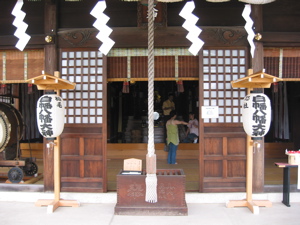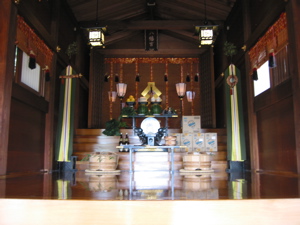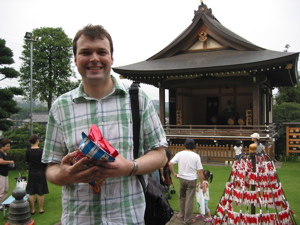
July 18th 2006
Today it has rained almost constantly. On the bright side, it has been fairly cool, which makes a nice change after a week of temperatures in the thirties. I gather that both my English and Californian readers know how I've been feeling.
Apart from the weather, it's been another good couple of weeks. Work is moving along nicely, with another editing project finished today. Student recruitment suffered a blow when the research trip to Paris that one student thought she was taking in the Autumn was moved forward to the week after next, so she's stopped. She may start again, though, once she gets back to Japan. We'll see. In the meantime, I've renewed all my adverts; I'm still averaging just under my target income, I think.
A couple of weeks ago, I had another lecture on Shinto, although the summer holidays have started now, so it will be a while until the next one. This one was about Shinto in the Japanese language, and talked about the origins of Japanese words. It was interesting, although rather difficult to explain in English, for the obvious reasons. The fact that one of the Japanese titles for kami originally means "The Word" was interesting, though.
The lecture did rely a bit on projecting back from written records into an unwritten past. I've studied enough in that field to know that it's deeply unreliable. "Ancient Customs" often means "Customs I remember from when I was a child", which doesn't make them much more ancient than the child in question. If no-one knows stories about them starting, you can probably push it back about a century, but in the absence of written records there may have been significant changes in detail in that time. The early days of literate culture often see great claims made for the accuracy of oral transmission by people criticising this new-fangled "writing" lark, but, obviously, in the absence of writing there's no way to check whether something has been accurately transmitted for centuries. The studies I'm aware of, where something has been orally transmitted and also preserved in writing, suggest that it can be amazingly good, and can also change things very significantly -- and there is no way to know which, unless there happens to be a written record.
Anyway, that weekend we went to visit one of Yuriko's aunts, and her husband. They live in Kanagawa, so it's an easy day trip. It doesn't actually take a lot longer to get there than to go into Tokyo, although it is the opposite direction. We had a very pleasant afternoon, chatting about travel, England, Japan, weddings, and so on. Yuriko's aunt ordered in sushi for dinner, which was very nice, and they must have been getting comfortable with me by that time because they were willing to agree with Yuriko that I was weird because I didn't drink -- to my face. In the end, we were there for about five hours, and I had a really good time. I haven't, as people may have noticed, encountered many problems of being rejected for not being Japanese.
As mentioned before, last week was very hot, and not much happened beyond work and complaining about the heat. On Saturday we had a really spectacular thunderstorm, with truly torrential rain and flashes of lightning several times a minute. It was enough to cause a brief (a couple of minutes) power cut. Yesterday was a national holiday (Ocean Day), and also wet, although not as wet as today. Yuriko and I stayed in and discussed a number of aspects of the wedding plans, so we've got a few more things decided now. We're not yet having to rush around in a panic, and I plan to keep it that way.
 The main building of the shrine from the outside, in its festival best. The paper lanterns are not normally there.
The main building of the shrine from the outside, in its festival best. The paper lanterns are not normally there.
Sunday was the summer festival at our local Shinto shrine. This was slightly unusual for a couple of reasons. First, there were no tako-yaki stalls; no stalls of any type, in fact. Apparently, this is because the stalls used to be set out in the fields just outside the shrine precincts, so the shrine never had the custom of setting them up inside. Now, of course, outside the shrine is largely houses (although there are actually still a few fields around; this part of Kawasaki is not as urban as you might imagine), so there is nowhere to put the stalls. Still, the shrine priest maintains the tradition of not having stalls inside the precincts, so there are none. (For the benefit of readers who have never been to a shrine festival, the food stalls are almost always present, particularly tako-yaki (fried octopus). To most Japanese, a festival is somewhere with those stalls.)
I'll come to the second reason shortly; it's the main feature of the festival.
The first stage of the festival is a norito, where the priest prays for the safety of all the the ujiko (people living in the shrine's area of influence). Yuriko and I arrived early enough to see that part, although we weren't actually attended the norito; we just waited outside. That was a lot like my formal shrine visit, except that the priest had an assistant, and there were about 20 people in the shrine.
There was then a break, and some Japanese music was played in the Kagura-den (the shrine has a separate music building). A member of the shrine family invited us into the haiden (I'm vague because I'm not sure exactly what her relationship is; I *think* she's the daughter of the priest, but I'm not absolutely sure), which gave Yuriko a chance to look around inside at her own pace.
The second part of the festival is unique to this shrine, but probably, to be honest, less broadly unusual than the absence of stalls. After all, most festivals are unique to most shrines. It is a so-called "Negimai", which means "Shrine Priest Dance". One unusual thing about this is that the priests do not usually dance; normally, the miko (the shrine maidens) dance.
According to the legend, this dance was first performed at the request of Tokugawa Ieyasu on the eve of Sekigahara, to pray for his success in battle. It has since been passed down from father to son, in a single line of succession, to the present shrine priest. (The shrine family are the Koizumis. At some point I must ask whether they have any connection to the Prime Minister of Japan.) Early in the Edo period, it is said to have been performed early in the New Year, at Edo Castle in the presence of the Shogun. These days, it is performed at our local shrine, at the summer festival and the Great Festival, which is in September.
There is probably some truth to the legend; the shrine still has the grant of court rank to the priest, and the writ of permission for various outfits from the Tokugawa bakufu. The latter is standard (although it's quite unusual for the piece of paper to survive); the latter is very unusual (at least according to the priest's wife), and suggests that the shrine had an unusually close relationship to the government at some point. Since it certainly doesn't now (well, unless the Prime Minister is the priest's cousin or something), I'm inclined to believe at least that the dance was performed at Edo Castle. There's nothing intrinsically implausible about Ieyasu asking for a special prayer for victory, either, but I'm not aware of any independent evidence for that bit, and there is a natural tendency to push the foundation story onto the most famous figure and the most famous event available.
At any rate, the dance goes back centuries, probably about 400 years. It has six sections.
In the first part, the priest, dressed normally (for a Shinto priest) dances with a bell-rattle and a gohei. The bell-rattle has lots of small bells on a frame, and a gohei is two strips of white paper, folded in shapes resembling lightning bolts, hanging from a wooden stick. The only accompaniment is a drum, and the sound of the bells. This is a purification dance, prior to the main dances.
There are five main dances. For each dance, the priest wears a different headdress, outer coat, and mask, and carries different objects in addition to the bell-rattle. The shrine has five masks going back to the early Edo period (another reason to believe that the dances go back a long way), but the ones used now are more recent copies. In each dance the priest takes on the persona of a different kami.
In the first dance, he is Sarutahiko no Mikoto, the kami who guided Ninigi no Mikoto down from Takama no Hara to Japan. The mask is a tengu mask: bright red, with a really long nose. He has a large hat, rather like the hat worn by Mr Punch in Punch and Judy, and carries a copper-coloured sword. (It quite possibly is copper.)
In the second dance, he is Amenouzume no Mikoto, the ancestral goddess of Kagura (Shinto dance) and the arts. In the Kojiki, she's the goddess who does a strip-tease in front of the cave where Amaterasu is sulking, and gets her to come out. This mask is white, with a wig of female-style hair, and the priest carries the gohei again.
 The festival offerings in the shrine. The boxes to the right of the round mirror contain the popcorn, and you can just see the bottles of sake to the left.
The festival offerings in the shrine. The boxes to the right of the round mirror contain the popcorn, and you can just see the bottles of sake to the left.
Then there was an interval. The ujiko handed out sake and popcorn (really, we got sacred popcorn to eat while watching the performance), and more people arrived. A lot of them were carrying plastic bags, which somewhat mystified us. All will become clear later...
The third dance personates Amenokoyane no Mikoto, who is the kami in charge of festivals (according to the information sheet I picked up at the festival). This mask is black and of an old man, and the wig is white. The priest carries the sword again, if I recall correctly.
The fourth dance is Hikohohodemi no Mikoto, the kami of mountain hunting. This is another black mask, and the priest carries a fan. Part way through the dance he puts down the fan, picks up a bow and some arrows, and shoots members of the audience. OK, so the arrows have no points and he shoots very gently... The arrows are presumably good luck, and he didn't fire them randomly. He shot one man sitting at the front directly in the chest, and I think the victim was one of the main helpers for the festival, so I suspect it was a way of saying "thank you".
The fifth and final dance is Ooyamazumi no Mikoto, the spirit of a local mountain. The mask is red, again, and has small tusks in the lower jaw, so it's a bit like an oni mask. For this dance the priest has the sword again, but puts it down to pick up a bucket with mochi in, which he throws at the audience. The reason for the plastic bags suddenly becomes clear! It was a small bucket, so he threw out a few handfuls and then showed us that the bucket was empty. One small girl was still standing with her bag held open hopefully.
 Me, holding the popcorn and prawn rice crackers we received, after the festival. The building in the background is the Kagura-den; if you look closely you can see the drums.
Me, holding the popcorn and prawn rice crackers we received, after the festival. The building in the background is the Kagura-den; if you look closely you can see the drums.
Her parents had clearly been before, unlike us. Six of the Ujiko went up into the rear of the shrine and moved two big buckets, which turned out to be full of mochi. They threw these to the audience, and we caught quite a few and had more land on our heads; we had several white rice flour marks afterwards. Fortunately, the person sitting next to us gave us a plastic bag to hold our haul, so we had dango in the evening, made from our mochi-nage mochi. (Mochi-nage means "mochi throwing".)
There was a bit more music after that, but that was basically the end of the festival. The priest came to check that we had caught some mochi (we had), and his wife brought us some cucumbers that had been offered by one of the ujiko, with whom we had a brief chat.
All in all, it was a very enjoyable couple of hours. I've never had rice-cakes thrown at me by someone in a demon-mask before, and certainly never as an intrinsic part of a religious ceremony. It was interesting that it felt rather like a local festival out in the countryside, rather than something happening in the Tokyo Megalopolis. I think the absence of stalls contributes to that; it makes things a bit quieter.
The main thing I'm hoping will happen over the next couple of weeks is that I will get a couple more work tasks finished. I have a deadline next Monday, so that one had better get finished. Everything is in good shape, though, so I'm not worried.